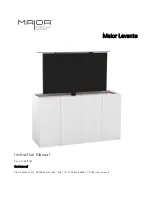
Circuit Descriptions, Abbreviation List, and IC Data Sheets
9.
•
Sets with TDA9178: for sets with TDA9178, the Dynamic
Skin Tone Control and Green Enhancement are controlled
in the TDA9178. The Blue Stretch is controlled by the
BOCMA and the Blue Stretch of the TDA9178 is switched
off.
When the TDA9178 is used, noise reduction is also available.
The action of the noise reduction has also influence on the
sharpness control: if a noisy signal is received then the noise
reduction should be high and sharpness low and vice versa.
9.6.4
Chroma and Luminance Processing
The BOCMA (IC7301-B) contains a chroma bandpass and trap
circuit (including a luminance delay line and the delay for the
peaking circuit). The centre frequency of the chroma bandpass
filter is switchable via the I2C-bus so that the performance can
be optimised for ‘front-end’ signals and external CVBS signals.
9.6.5
Colour Decoder
The colour decoder (demodulator) can decode PAL, NTSC,
and SECAM signals. The internal clock signals for the various
colour standards are generated by means of an internal VCO,
which uses the 12 MHz crystal (item 1330) frequency as a
reference.
Under bad-signal conditions (e.g. VCR-playback), it may occur
that the colour killer is activated although the colour PLL is still
in lock. When this killing action is not wanted it is possible to
overrule it.
The IC contains an Automatic Colour Limiting (ACL) circuit,
which is switchable via the I2C-bus, and which prevents that
over saturation occurs when signals with a high chroma-to-
burst ratio are received.
The reference frequency of the colour decoder is fed to the
FSC output (pin 49) and can be used to tune an external comb
filter.
The base-band delay line is integrated. The demodulated
colour difference signals are internally supplied to the delay
line. The colour difference matrix switches automatically
between PAL/SECAM and NTSC.
9.6.6
Picture improvement features
In the BOCMA, various picture improvement features have
been integrated. These features are:
•
Video dependent coring in the peaking circuit. The coring
can be activated only in the low-light parts of the screen.
This effectively reduces noise while having maximum
peaking in the bright parts of the picture.
•
Colour Transient Improvement (CTI). This circuit improves
the rise and fall times of the colour difference signals.
•
Black-stretch. This circuit corrects the black level for
incoming video signals, which have a deviation between
the black level and the blanking, level (back porch).
•
Blue-stretch. This circuit is intended to shift colour near
‘white’ with sufficient contrast values towards more blue to
obtain a brighter impression of the picture
•
White-stretch. This function adapts the transfer
characteristic of the luminance amplifier in a non-linear way
dependent on the picture content. The system operates
such that maximum stretching is obtained when signals
with a low video level are received. For bright pictures, the
stretching is not active.
•
Dynamic skin tone (flesh) control. This function is realised
in the YUV domain by detecting the colours near to the skin
tone. The correction angle can be controlled via the I2C-
bus.
9.6.7
RGB Output
The ICs have a flexible control circuit for RGB and YUV input
signals which has the following features:
•
Input, which can be used for YUV or RGB, input signals
and as YUV interface. The selection of the various modes
can be realised via the I2C-bus. For the YUV input 2
different input signal conditions can be chosen It is also
possible to connect the synchronisation circuit to the
incoming Y input signal. This input signal can be controlled
on saturation, contrast, and brightness.
•
The RGB-1 input which is intended for OSD/text signals
and which can be controlled on contrast and brightness. By
means of software, the insertion blanking can be switched
"on" or "off". It is also possible to convert the incoming
RGB-1 signal to a YUV signal. The resulting signal is
supplied to the YUV outputs.
•
The TDA888x versions have an additional YUV or RGB
input which can be controlled on contrast, saturation, and
brightness. This signal is supplied to the control circuit via
the YUV interface so that an external picture improvement
IC will also have effect on this signal.
9.6.8
Synchronisation (diagrams A4 and A5)
Horizontal Sync (H Sync)
Before the video processor IC7301 can generate horizontal
drive pulses (LINEDRIVE, pin 56), the supply voltages on both
pins 23 and 53 must be present. After the start-up command of
the Painter (via the I2C), the BOCMA starts giving horizontal
pulses.
Vertical Sync (V Sync)
The vertical sawtooth generator drives the vertical output drive
circuit. On pins 63 and 64 are two differential voltages DR+ and
DR-. For this chassis, only DR- is used. This line is called V-
SYNC, and goes to the Painter microprocessor.
Composite Sync (C Sync)
On pin 57 of IC7301 the sandcastle pulse (SC) is available.
This is a 2-state pulse that is used for synchronisation of the
(optional) histogram IC (item 7403).
Together with the LINEDRIVE pulse, this signal is also used to
create the C-SYNC signal, which is used to synchronise the
Scaler board.
9.7
Video: Scaler Board
The Scaler Board controls the display processing in an LCD
TV, e.g. like the deflection circuit in a CRT-based TV. It controls
all the view modes (e.g. like "zooming" and "shifting"). Features
like PC (VGA) or HD inputs, are also handled by this board.
Figure 9-4 Block diagram Scaler board
CL 36532023_080.eps
110403
Fli2300
Deinterlacer,
Scaler,
Video Processing
jagASM
PC Processing,
PC FRC,
Video Processing,
OSD, PiG CLUT
Micro
Controller
Flash
Memory
EXTERNAL
AC-DC
Adapter
LVDS
LCD
PANEL
SDRAM
SAA7118
SDTV A/D
AD9883
HD A/D
DC-DC
CONVERTER
INVERTER
NVM
I
2
C
MCA
I
2
C-1
(To TV)
HD
SDTV
(From TV board)
SDRAM
PC
















































